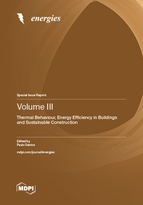Volume III: Thermal Behaviour, Energy Efficiency in Buildings and Sustainable Construction
A special issue of Energies (ISSN 1996-1073). This special issue belongs to the section "G: Energy and Buildings".
Deadline for manuscript submissions: closed (20 July 2023) | Viewed by 20512
Special Issue Editor
Interests: sustainability; thermal behaviour and energy efficiency of buildings; lightweight steel framed (LSF) construction; construction safety management; boundary elements method
Special Issues, Collections and Topics in MDPI journals
Special Issue Information
Dear Colleagues,
Currently, energy and sustainability are two of the major concerns of humankind. Given the relevant energy consumption share of the buildings sector, it is very important to search for innovative design solutions and for the optimal thermal performance of buildings in order to reduce energy bills and greenhouse gas emissions, while maintaining the comfort levels of the occupants. Additionally, given the environmental burdens of the construction sector, seeking more environmentally responsible processes and a more efficient use of resources is currently attracting more attention.
This Special Issue is dedicated to the analysis of the recent advances on the following topics: (1) the thermal behaviour improvement of a building’s elements (e.g., walls, floors, roofs, windows, doors, etc.); (2) energy efficiency in buildings; and (3) sustainable construction. All types of the following research approaches are acceptable: experimental, theoretical, numerical, analytical, computational, case studies, and their combinations. The main criteria for paper acceptance are academic excellence; scientific soundness; and the originality and novelty of applications, methods, fundamental findings, or experiments.
The Special Issue will include the following topics:
- Thermal behaviour improvement of a building’s components (e.g., walls, floors, roofs, windows, doors, etc.);
- Thermal bridges assessment and mitigation;
- Energy efficiency in buildings;
- Thermal inertia increase techniques (e.g., use of PCMs—phase change materials);
- Building location and climate—air temperature, solar radiation, relative humidity, wind speed and direction, ground temperature, daylight hours, and so on;
- Building envelope—air tightness, thermal insulation, glazed openings, shading, and so on;
- Building services—appliances, illumination, heating, air-conditioning, ventilation, heat recover, hot water production, and so on;
- Human factors—occupancy schedule, utilization type, internal heat gains, and so on;
- Passive heating and cooling techniques—natural ventilation, solar heat gains, Trombe walls, ground source heat exchangers, and so on;
- Renewable energy sources for building applications—solar collectors for domestic hot water production, photovoltaic solar panels, wind turbines, and so on;
- Optimization of thermal behaviour and of energy efficiency of buildings;
- Environmental life-cycle assessment of buildings and building components;
- Life-cycle cost assessment of buildings and building components;
- Building’s operational and embodied energy.
Prof. Dr. Paulo Santos
Guest Editor
Manuscript Submission Information
Manuscripts should be submitted online at www.mdpi.com by registering and logging in to this website. Once you are registered, click here to go to the submission form. Manuscripts can be submitted until the deadline. All submissions that pass pre-check are peer-reviewed. Accepted papers will be published continuously in the journal (as soon as accepted) and will be listed together on the special issue website. Research articles, review articles as well as short communications are invited. For planned papers, a title and short abstract (about 100 words) can be sent to the Editorial Office for announcement on this website.
Submitted manuscripts should not have been published previously, nor be under consideration for publication elsewhere (except conference proceedings papers). All manuscripts are thoroughly refereed through a single-blind peer-review process. A guide for authors and other relevant information for submission of manuscripts is available on the Instructions for Authors page. Energies is an international peer-reviewed open access semimonthly journal published by MDPI.
Please visit the Instructions for Authors page before submitting a manuscript. The Article Processing Charge (APC) for publication in this open access journal is 2600 CHF (Swiss Francs). Submitted papers should be well formatted and use good English. Authors may use MDPI's English editing service prior to publication or during author revisions.






